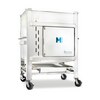IHCR1002-6 Sigma-AldrichAnti-APP A4 Antibody, a.a. 66-81 (NT), Prediluted, clone 22C11
Detect Alzheimer Precursor Protein A4 using this Anti-APP A4 Antibody, a.a. 66-81 (N-terminus), Prediluted, clone 22C11 validated for use in IH(P).
More>> Detect Alzheimer Precursor Protein A4 using this Anti-APP A4 Antibody, a.a. 66-81 (N-terminus), Prediluted, clone 22C11 validated for use in IH(P). Less<<Recommended Products
Overview
| Replacement Information |
|---|
Key Spec Table
| Species Reactivity | Key Applications | Host | Format | Antibody Type |
|---|---|---|---|---|
| Ca, H, M, Mk, Po, R, F | IH(P) | M | Purified | Monoclonal Antibody |
| References |
|---|
| Product Information | |
|---|---|
| Format | Purified |
| Presentation | Liquid diluted in PBS, pH 7.2 with stabilizers, 0.2% Tween 20, and 0.1% Kathon as preservative. |
| Quality Level | MQ100 |
| Physicochemical Information |
|---|
| Dimensions |
|---|
| Materials Information |
|---|
| Toxicological Information |
|---|
| Safety Information according to GHS |
|---|
| Safety Information |
|---|
| Storage and Shipping Information | |
|---|---|
| Storage Conditions | Maintain at 2-8°C. Refer to vial for expiration dating. |
| Packaging Information | |
|---|---|
| Material Size | 6 mL |
| Transport Information |
|---|
| Supplemental Information |
|---|
| Specifications |
|---|
| Global Trade Item Number | |
|---|---|
| Catalogue Number | GTIN |
| IHCR1002-6 | 04053252508905 |
Documentation
Anti-APP A4 Antibody, a.a. 66-81 (NT), Prediluted, clone 22C11 SDS
| Title |
|---|
Anti-APP A4 Antibody, a.a. 66-81 (NT), Prediluted, clone 22C11 Certificates of Analysis
Data Sheet
| Title |
|---|
| MILLIPORE IHC SELECT RESEARCH® PREDILUTED MOUSE ANTI- ALZHEIMER PRECURSOR PROTEIN A4 MONOCLONAL ANTIBODY |















